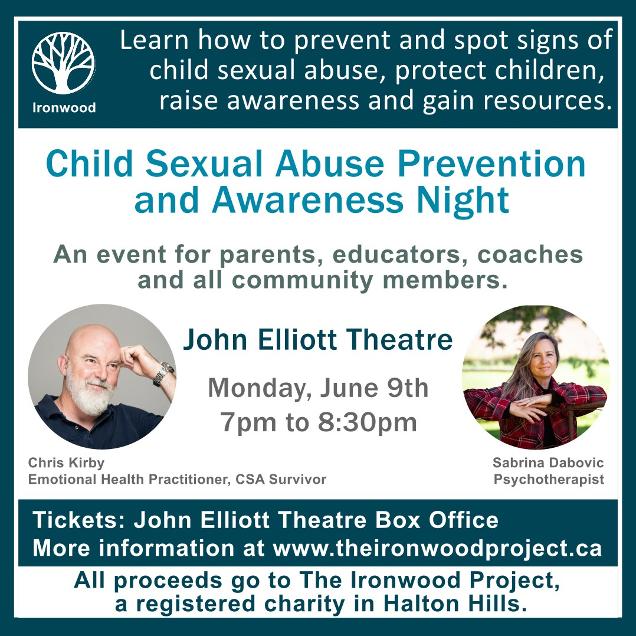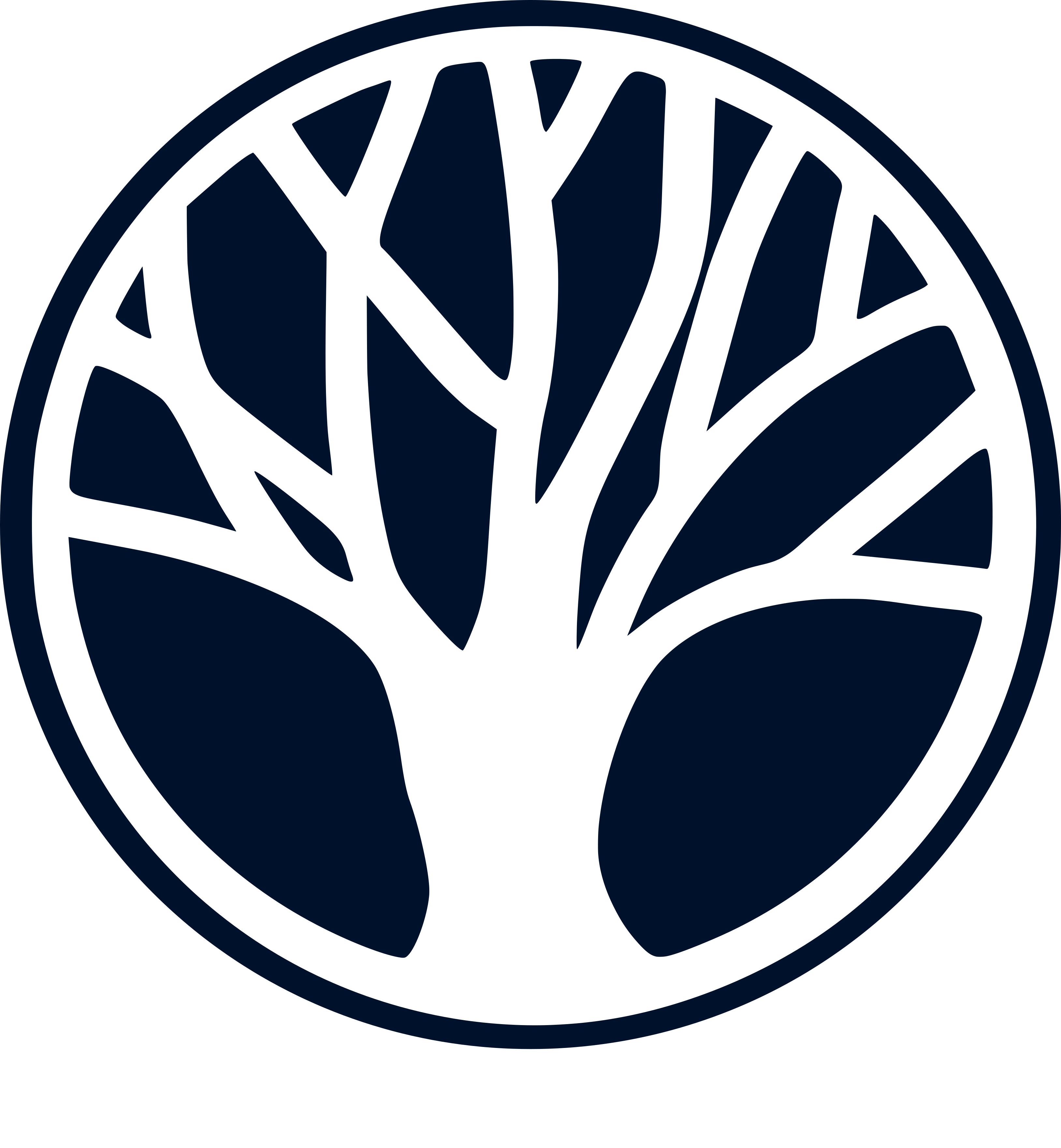

The Ironwood Project presents
Child Sexual Abuse Prevention and Awareness Night
Learn how to prevent and spot child sexual abuse, protect children, raise awareness and gain resources.
Join us on Monday, June 9th, 2025 from 7pm to 8:30pm at John Elliott Theatre in downtown Georgetown. Doors open at 6:30. Tickets are $20 with all proceeds going to The Ironwood Project charity.
Tickets go on sale Tuesday March 28th exclusively at the John Elliott Theatre box office.
Our hosts are Chris Kirby, Emotional Health Practitioner (qualifying), survivor and Program Director of The Ironwood Project with Sabrina Dabovic, Psychotherapist and Ironwood Project Board Member.
Information, Resources and Sources
What is Child Sexual Abuse?
Child sexual abuse includes a range of behaviours, from obvious contact offences, such a sexual touching, to the less obvious non-contact offences, such as those listed below. It is important to note that children can experience sexual abuse and harm without a contact offence occurring.2 A child cannot consent to any form of sexual activity, period. When a perpetrator engages with a child this way, they are committing a crime that can have lasting effects on the victim for years.4
What is Non-contact Sexual Abuse?
Non-touching behaviors when an abuser does not make physical contact with a child.
- Asking sexual questions or making sexual comments to a child.
- Voyeurism (i.e.: secretly watching or recording a child’s private activities)
- Inviting a child to sexually touch herself/himself or another person.
- Exposing a child to pornography or sexual acts.
- Exposing genitals to a child.
- Exhibitionism, or exposing oneself to a minor
- Masturbation in the presence of a minor or forcing the minor to masturbate
- Obscene conversations, phone calls, text messages, or digital interaction
- Owning or sharing pornographic images or movies of children
What is Contact Sexual Abuse?
Contact abuse happens when an abuser makes physical contact with a child.
- With or without force sexual touching of any part of a child’s body, where they are clothed or not.
- Using a body part or object to rape or penetrate a child
- Coercing or forcing a child to take part in sexual activities
- Fondling
- Intercourse
- Sex of any kind with a minor, including vaginal, oral, or anal
- Sex trafficking
- Any other contact of a sexual nature that involves a minor
- Producing pornographic images or movies of children
Statistics
Sexual offences are among the most underreported crimes in Canada.
Between 30 and 40 per cent of sexual assault victims are abused by a family member.
- Non-parental relatives – 35%
- Friends and peers – 15%
- Stepfathers – 13%
- Biological fathers – 9%
- Other acquaintances – 9%
- Boyfriend/girlfriend of biological parent – 5%
- Biological mothers – 5%
Approximately 20% of the victims of sexual abuse are under the age of eight. (Broward County)
A typical pedophile will commit 117 sexual crimes in a lifetime. (National Sex Offenders Registry)
More than 90% of individuals with a developmental delay or disability will be sexually assaulted at least once in their lifetime. (Valenti-Heim, D.m Schwartz L.)
Most sexual abuse happens to children between the ages of 7 and 13 (U.S. Department of Justice)
1 in 5 children are solicited sexually while on the Internet before the age of 18.(National Children’s Alliance: Nationwide Child Abuse Statistics)
95% of sexual abuse is preventable through education. (Child Molestation Research and Prevention Institute)
Warning Signs
What are the warning signs?
Child sexual abuse isn’t always easy to spot and some survivors may not exhibit obvious warning signs. The perpetrator could be someone the child has known for a long time or trusts, which may make it even harder to notice. Consider some of the following common warning signs:
Physical signs:
- Bleeding, bruises, or swelling in genital area
- Bloody, torn, or stained underclothes
- Difficulty walking or sitting
- Frequent urinary or yeast infections
- Pain, itching, or burning in genital area
Behavioral signs in children:
- Changes in hygiene, such as refusing to bathe or bathing excessively
- Develops phobias
- Exhibits signs of depression or post-traumatic stress disorder
- Expresses suicidal thoughts, especially in adolescents
- Has trouble in school, such as absences or drops in grades
- Inappropriate sexual knowledge or behaviors
- Nightmares or bed-wetting
- Overly protective and concerned for siblings, or assumes a caretaker role
- Returns to regressive behaviors, such as thumb sucking
- Runs away from home or school
- Self harm
- Shrinks away or seems threatened by physical contact
- Acting more mature than peers
- Someone is trying to normalize sex around child
- Someone treating a child older than they are
- Secret keeping
What is Grooming?
Grooming is a method used by sexual offenders to gain access to children for sexual abuse purposes. It is often a slow, gradual and escalating process of building trust and comfort with a child and the adults around the child.
Who are Groomers?
Individuals abuse their positions of trust and authority with children. (commit to kids)
- Usually know the child
- Are often well liked by those in the community
- Come from all walks of life
- Cannot be picked out or identified by their appearance or character traits as a perpetrator
The purpose of grooming is to:
- Manipulate the perception of the people so they believe the person is safe with the child
- Desensitize a child and normalize inappropriate behaviour
- Increase the compliance of the child
- Reduce the likelihood of a disclosure
- Reduce the likelihood of the child being believed if s/he discloses
Examples of grooming behaviour may include:14 (https://www.schools.vic.gov.au/child-sexual-exploitation-and-grooming)
- Asking a child to keep secrets. The secrets usually start small like a treat or breaking a small rule.
- giving gifts or special attention to a child or young person, or their parent or carer, making the child or young person feel special or indebted to an adult
- making close physical contact sexual, such as inappropriate tickling and wrestling or play fighting
- openly or pretending to accidentally expose the victim to nudity, sexual material and sexual acts (this in itself is classified as child sexual abuse but can also be a precursor to physical sexual assault)
- controlling a child or young person through threats, force or use of authority making the child or young person fearful to report unwanted behaviour.
Outcomes
Possible long term psychological effects of sexual abuse:
- PTSD
- Depression
- Anxiety
- Substance abuse
- Eating disorders
- Suicide
- Risky sexual behaviour
- Trust issues
- Fear of intimacy
- Unstable relationships
- High divorce rates
- Re-victimization
- Heart disease
- Cancer
- Diabetes
- Obesity
- STI
- Teen pregnancy
How to Support a Child During a Disclosure:
Listen
Coming forward to disclose takes a lot of courage on behalf of a child. There are fears she/he won’t be believed or of an adult reaction. Listen attentively and avoid sharing your own stories or experiences. If the child feels they are being judged or not believed, or you have a reaction that overwhelms her/him, she/he is likely to shut down and stop the disclosure.
Praise for Telling
A child will often believe she/he is responsible for the abuse. Assure the child that it is not her/his fault and that she/he did the right thing by telling you.
Privacy
Respect the child’s need for privacy and confidentiality. Make sure other children are not around to hear the child’s disclosure. Only adults who will be directly involved in taking action should be present.
Take it Seriously
Let the child know that you take her/his disclosure seriously. Make the child feel as safe as possible by using a calm voice and manage your own reaction to the disclosure. Make sure to follow up with the child and the process.
Source List
- Department of Justice Canada, “Backgrounder - Sexual Offending Against Children and Youth” February 2013)
- “Commit to Kids Guide for Parents” Canadian Centre for Child Protection, 2016
- Source: Canadian Incidence Study (CIS) of Reported Child Abuse and Neglect – 2003: Major Findings Minister of Public Works and Government Services Canada. 2005. (pg.52)
- https://www.rainn.org/articles/child-sexual-abuse
- www.helpingsurvivors.org
- https://www.cdc.gov/violenceprevention/childsexualabuse/fastfact.html
- https://www.nationalchildrensalliance.org/media-room/national-statistics-on-child-abuse/
- Broward County www.broward.org
- National Sex Offenders Registry https://www.registeredoffenderslist.org/default.htm
- Valenti-Hein, D., & Schwartz, L. (1995). The sexual abuse interview for those with developmental disabilities. James Stanfield Company. Santa Barbara: California.
- National Center for Victims of Crime https://victimsofcrime.org/child-sexual-abuse-statistics/#:~:text=Over%20the%20course%20of%20their,ages%20of%207%20and%2013.
- https://www.nationalchildrensalliance.org/media-room/national-statistics-on-child-abuse/
- https://www.childmolestationprevention.org/tell-others-the-facts
- https://www.schools.vic.gov.au/child-sexual-exploitation-and-grooming
- https://www.oct.ca/resources/advisories/duty-to-report
- ProtectKidsOnline.ca
- https://www.ontario.ca/document/health-and-physical-education-grades-1-8/human-development-and-sexual-health-education-grade
- My First Safety Book - Canadian Centre for Child Protection
Resources
Canadian Centre for Child Protection - Lots of information with resources to share with children, particularly in a classroom setting.
Little Warriors - Supporting prevention and awareness. Canadian based.
Darkness to Light - A world wide program that empowers adults to protect children. Based in the United States,
Protect Kids Online - Online grooming is a growing concern. Check out there suggestions.
Prevent Child Abuse - A source for statistics and facts. Based in the United States.
© Copyright theironwoodproject
